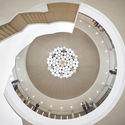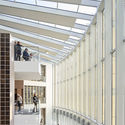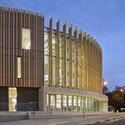
-
Architects: FaulknerBrowns Architects
- Area: 4115 m²
- Year: 2016
-
Photographs:Hufton+Crow
-
Manufacturers: Atelje Lyktan, Bespoke Concrete, Classic Masonry, James & Taylor, Teams roofing, Topside

Text description provided by the architects. In a modern society in which we all enjoy immediate access to information 24 hours a day, 7 days a week, then what should a library for the 21st century look like and what should it offer to the public? This was the simple question which The Word, National Centre for the Written Word seeks to answer.
It was clear to us that to respond to this challenge would require a reinterpretation of the building typology.

The site for The Word is an extremely prominent gateway to the town centre. It provides a strong link between the Ferry Terminal and South Shields town centre and serves to link the riverside character area with the town centre and historically important market place in South Shields.


The building concept adopts a simple circular form to reinforce the pedestrian link and views between the Harton Quays Riverside Park and market place. The building’s appearance is inspired by the fanning out of the pages of a book, and includes the introduction of two large glass walls providing superb views of the River Tyne and creating a natural place for the building’s entrance, responding to the public realm of the market place.

The central atrium forms the entrance gateway into the building, expressed externally as a modern portico with full height glazing, creating a strong and contextual relationship with the market place, The Old Town Hall and St Hilda’s Church.

The Word provides a rich array of volumes ranging from the grand social forum in the central atrium to the most private and individually concentrated reader spaces at the perimeter of the building. An array of interactive activities are positioned close to the inner circle of the building providing easy and quick access to these attractions. The Word is not a temple for silence, but a place for sharing knowledge, where the young can learn from the old and the old can learn from the young.

The Word’s design is truly transformative in every sense. It not only helps to transform the character of the site and context, but also helps to transform a visitor’s perception of what a library can be and how it can form part of a larger cultural venue of regional and national significance. It recognises the crucial importance of people, books, traditional media and interactive technologies, and the dynamic relationship and complex interactions between them.

The human-centric design approach places the individual at the heart of the building and celebrates the opportunity to inform, delight and interact. Libraries are of vital importance - they allow us to engage with stories. This in turn allows us to see the world through someone else’s eyes, to see their point of view – enabling us to be more understanding, more tolerant and more human, helping to create a more cohesive and inclusive community and society. The design of The Word empowers this strategy by creating a significant and civilised building which points to the future and underlines the importance of the library within our modern society.

Product Description. - The Word – National Centre for the Written builds upon the long tradition of a circular building form to accommodate a library function. There is a fine architectural tradition of the synonymous relationship such as the Bodleian Library in Oxford or Manchester’s Central Library. To achieve the circular building form and to respond to the site’s sensitive context a 140mm wide vertical terracotta baguette was selected as the building’s main external cladding. Three colour tones of terracotta panels were adopted to respond to the colour of the stone used in the construction of the listed buildings which surround the site. The vertical module enabled the circular form of the building to be achieved without the use of curved panels – this combined with a structurally insulated panel (SIPs) helped to create an elegant and economic envelope solution.
























103_Rev_A_base_Image.jpg?1481766102)
101_Rev_A_base_drawing.jpg?1481765999)
